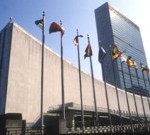 BY STEVEN EDWARDS
BY STEVEN EDWARDSBold statements about the need to save the world's trees poured into the United Nations last week at a massive conference called the Forum on Forests
And yet the world body produces so many reports daily it is known as the globe's most prodigious paper factory.
Which wouldn't be so bad if someone were getting some benefit from all the printed words.
Alas, most of the reports go unread, their shelf life being just a few days as they pass from racks marked "today's documents," to "recent documents," and finally to giant plastic bins for recycling.
The UN conservatively estimates 700 million pages stream off its printing presses every year. Critics say the total is closer to 2 billion.
Shashi Tharoor, chief of the UN's public information department, argues that the world body uses no more paper in a single year than a Sunday edition of a big American newspaper. He neglects to mention people are prepared to read the newspaper - and pay for it.
There is no sale value for UN reports, some issued as glossy, high-color books, others simply plain sheets of paper.
Their extended titles hint at the length of the full documents. One from UN Secretary-General Kofi Annan is headed: "Integrated and coordinated implementation of and follow-up to the outcomes of the major United Nations conferences and summits in the economic, social and related fields - Follow-up to the outcome of the Millennium Summit - Modalities, format and organization of the high-level plenary meeting of the 60th session of the General Assembly."
Which leads many senior UN officials to simply refer to the codes attached to the reports. But this can cause more confusion, as the chief administrator of the UN's war crimes court for Rwanda discovered over the weekend, when he told staff in a 10-page address how "puzzled" he was about allegations some of them had been abusing local African women.
"The event prompts me to remind everybody about the need ... to act ... in compliance with...ST/SGB/200-3/13," he scolded.
To ensure everyone falls in line, he said he'd instructed his human resources chief to again "make available to all staff members ... copies of the said ST/SGB/200-3/13."
Around the globe, scores of affiliated UN agencies and commissions issue millions of pages of additional reports.
The cultural and scientific agency UNESCO, for example, offers progress briefings on its Dialogue Among Civilizations project. One says: "We are convinced that dialogue represents a new paradigm of security."
That could be, but the project was an idea from Iran, one of whose other ideas is also generating a lot of reports from the UN's nuclear watchdog, which suspects the Islamic republic is building a nuclear bomb.
So many documents are issued by its various branches the UN feels the need to print additional volumes to list the annual output.
The length of a final report constitutes just a fraction of the paper used to produce it.
A committee will first issue a working paper, before putting together a draft resolution, followed by a resolution, and then the committee's report. This, in turn, is used as a working paper by the full UN body, which turns it into a draft resolution, before producing a final resolution, and only then issuing the final report.
Throughout this process, entire teams are employed, including researchers, drafters, translators, support staff, proofreaders and printers.
The latter work in a football field-sized complex beneath the north garden, and take almost five times as many sick days, twice the amount of vacation and twice as much break time as workers in private U.S. print shops.
One 1990s estimate suggests the UN consumes at least 100,000 trees a year.



